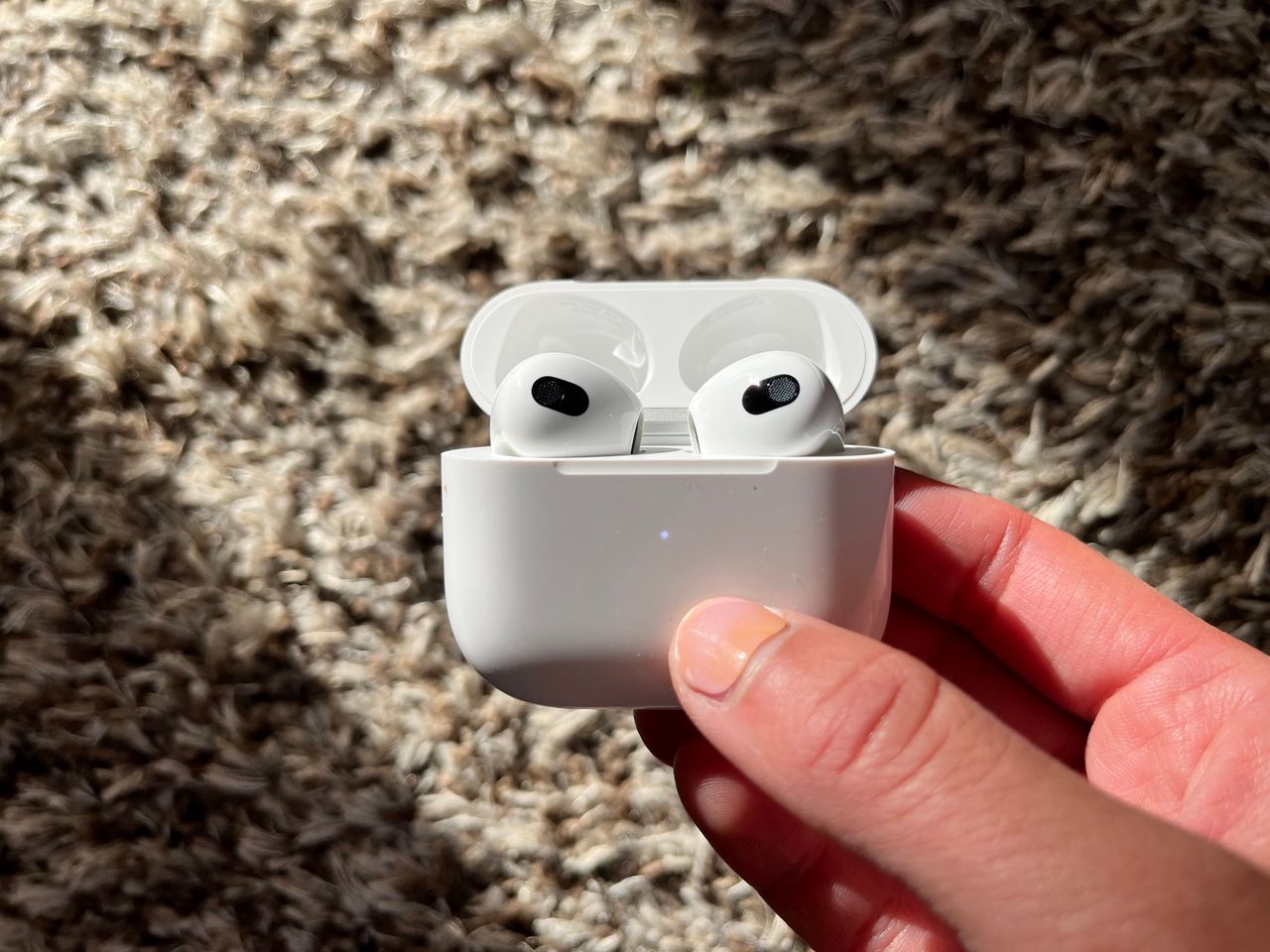New Apple AirPods Review: Great Sound, if They Stay in Your Ears
The third-generation AirPods feature better sound, battery life and water resistance, but have a different shape that might not fit your ears.
I was leaning over the sink, washing my face, when one of the new third-generation AirPods had a brush with death. The right earbud popped out and bounced, then bounced again, before landing inches from the wide-open drain.
Unlike their predecessor, these AirPods are water-resistant. I’m just glad the bud didn’t fall where only the bravest would follow. Many an AirPod has tumbled into subway tracks, sewer grates and toilets, and unfortunately the latest generation won’t prevent more from meeting the same fate. But they do sound better.
A new version of Apple’s AirPods wireless earbuds start shipping Tuesday. At $279, they’re more expensive than the previous generation, now down to $129 from $159. And they’re not quite as full-featured as the most expensive option, the $399 AirPods Pro with active noise cancellation.
There are several reasons an early AirPods adopter might want to upgrade to the third generation. The stem-squeezing capacitive touch controls are much easier to trigger than the original’s tap-based gestures. The battery life is an hour longer, with up to six hours of listening and four hours of talk time. The case conveniently snaps to MagSafe wireless chargers (sold separately). They’re now sweat- and water-resistant. And the stems are shorter, like the ones on the AirPods Pro. You’ll still look like a cyborg, but a little less so.
My chief concern is the fit: The new bud might not work for ears that held the original AirPods well.
A Different Fit
Everyone has a slightly different ear shape and so earbuds can be a highly personal choice—yet the non-Pro AirPods continue to be one-size-fits-all. The new AirPods fell out of my ears more often than the older ones, which I wore daily until I upgraded to the AirPods Pro. The new bud is more oval, and the tip has a larger, less-tapered end than the second-generation AirPods.
As is the case with all AirPods, every time I took off a sweater or tucked my hair behind my ear, a bud could go flying. But something about the new design caused the earbuds to drop when I was just eating or washing my face. Body movement seems to be less of an issue than jaw movement: I went on a run and the new ’Pods stayed put. The AirPods Pro, which come with three different sizes of silicone gasket, are the most secure in my ears. Meanwhile, my husband Will tried on the new AirPods and they work fine for him.
An Apple spokesman said the rounder shape is designed to make wearing the AirPods more comfortable. But the new fit and improved sound won’t make a difference if the earbuds can’t stay in your ear.
My advice? Try them on at the Apple Store before buying, or take advantage of Apple’s 14-day return policy. If they don’t fit, consider the AirPods Pro, which can be sized.
Better Audio
Most people aren’t buying AirPods for their sound. The killer feature is the quick-pairing setup for people who use iPhones, iPads and Macs.
For those who are paying attention to sound, the new AirPods have noticeably improved quality. Songs sound more detailed compared with the previous generation, and the bass is punchier in tracks ranging from the Supremes’ classic “You Can’t Hurry Love” to Billie Eilish’s room-shaking “Oxytocin.”
And if you don’t have an ear for music, you’ll still hear the difference when watching supported TV shows or movies with a compatible iOS device or Mac and spatial audio turned on. The feature enables three-dimensional audio from apps such as HBO Max, Disney+, Netflix and Hulu. (YouTube and Amazon Prime Video don’t support it yet.)
As you turn your head, the immersive sound feels like it’s emanating from the screen you’re watching. It’s confusing at first. It’ll sound like audio is playing out loud rather than in your earbuds. Try it with the first episode of “Squid Game” on Netflix. (That climactic scene, where the participants realize what’s up—that will hit you differently.)
Apple Music offers spatial audio on many tracks. The sound is sometimes amazing and three dimensional—check out “Latch” by Disclosure—but often you won’t notice anything at all.
My voice sounded better over the new AirPods’ microphones, too. The buds have the same mic and wind-minimizing material as the more expensive Pros, which came out on top in my testing last year.
Pros Vs. ’Pods—Or Something Else?
Apple has three earbuds in its lineup: second-gen AirPods for $219, new AirPods for $279 and AirPods Pro for $399.
Rubbery ear tips aren’t for everyone, but I still believe the Pros are the best earbuds iPhone users can buy. They’re $120 more, so they pose a confusing decision for upgraders. This past week, I really missed the Pros’ active noise cancellation. Walking down the street I had to crank up the AirPods’ volume to hear a podcast. And later, while working from home, I couldn’t tune out my neighbour’s leaf blower. The Pros’ noise cancellation isn’t as good as what you get in over-ear headphones, but it’s better than the in-ear competition.
While the new AirPods are a compelling upgrade from the original, $279 is a lot for earbuds without noise cancellation. Amazon’s bulkier Echo Buds 2 have active noise cancellation and come with optional wing tips for an even more secure fit.
AirPods also can’t simultaneously connect to two non-Apple devices at once like Jabra’s Elite 85t, and don’t have on-device volume control like Sony’s WF-1000XM4s.
And unfortunately, AirPods, like most wireless headphones and earbuds, are disposable. Their batteries, which will eventually degrade, can’t be replaced. Apple says it will recycle dead buds for you at any Apple Store, but there’s no trade-in credit.
Still, there’s a reason why AirPods are the bestselling wireless earbuds with 23% market share world-wide, according to the latest unit-sales estimate from Counterpoint Research. Earbuds work best with devices made by the same company, when they’re optimised for connection reliability and quick pairing. And for people who live in Apple’s walled garden, that means choosing AirPods—and trying not to lose them. The third-generation AirPods feature better sound, battery life and water resistance, but have a different shape that might not fit your ears.
Reprinted by permission of The Wall Street Journal, Copyright 2021 Dow Jones & Company. Inc. All Rights Reserved Worldwide. Original date of publication:October 25, 2021.
 Copyright 2020, Dow Jones & Company, Inc. All Rights Reserved Worldwide. LEARN MORE
Copyright 2020, Dow Jones & Company, Inc. All Rights Reserved Worldwide. LEARN MORE
This stylish family home combines a classic palette and finishes with a flexible floorplan
Just 55 minutes from Sydney, make this your creative getaway located in the majestic Hawkesbury region.
As Paris makes its final preparations for the Olympic games, its residents are busy with their own—packing their suitcases, confirming their reservations, and getting out of town.
Worried about the hordes of crowds and overall chaos the Olympics could bring, Parisians are fleeing the city in droves and inundating resort cities around the country. Hotels and holiday rentals in some of France’s most popular vacation destinations—from the French Riviera in the south to the beaches of Normandy in the north—say they are expecting massive crowds this year in advance of the Olympics. The games will run from July 26-Aug. 1.
“It’s already a major holiday season for us, and beyond that, we have the Olympics,” says Stéphane Personeni, general manager of the Lily of the Valley hotel in Saint Tropez. “People began booking early this year.”
Personeni’s hotel typically has no issues filling its rooms each summer—by May of each year, the luxury hotel typically finds itself completely booked out for the months of July and August. But this year, the 53-room hotel began filling up for summer reservations in February.
“We told our regular guests that everything—hotels, apartments, villas—are going to be hard to find this summer,” Personeni says. His neighbours around Saint Tropez say they’re similarly booked up.
As of March, the online marketplace Gens de Confiance (“Trusted People”), saw a 50% increase in reservations from Parisians seeking vacation rentals outside the capital during the Olympics.
Already, August is a popular vacation time for the French. With a minimum of five weeks of vacation mandated by law, many decide to take the entire month off, renting out villas in beachside destinations for longer periods.
But beyond the typical August travel, the Olympics are having a real impact, says Bertille Marchal, a spokesperson for Gens de Confiance.
“We’ve seen nearly three times more reservations for the dates of the Olympics than the following two weeks,” Marchal says. “The increase is definitely linked to the Olympic Games.”

Getty Images
According to the site, the most sought-out vacation destinations are Morbihan and Loire-Atlantique, a seaside region in the northwest; le Var, a coastal area within the southeast of France along the Côte d’Azur; and the island of Corsica in the Mediterranean.
Meanwhile, the Olympics haven’t necessarily been a boon to foreign tourism in the country. Many tourists who might have otherwise come to France are avoiding it this year in favour of other European capitals. In Paris, demand for stays at high-end hotels has collapsed, with bookings down 50% in July compared to last year, according to UMIH Prestige, which represents hotels charging at least €800 ($865) a night for rooms.
Earlier this year, high-end restaurants and concierges said the Olympics might even be an opportunity to score a hard-get-seat at the city’s fine dining.
In the Occitanie region in southwest France, the overall number of reservations this summer hasn’t changed much from last year, says Vincent Gare, president of the regional tourism committee there.
“But looking further at the numbers, we do see an increase in the clientele coming from the Paris region,” Gare told Le Figaro, noting that the increase in reservations has fallen directly on the dates of the Olympic games.
Michel Barré, a retiree living in Paris’s Le Marais neighbourhood, is one of those opting for the beach rather than the opening ceremony. In January, he booked a stay in Normandy for two weeks.
“Even though it’s a major European capital, Paris is still a small city—it’s a massive effort to host all of these events,” Barré says. “The Olympics are going to be a mess.”
More than anything, he just wants some calm after an event-filled summer in Paris, which just before the Olympics experienced the drama of a snap election called by Macron.
“It’s been a hectic summer here,” he says.

AFP via Getty Images
Parisians—Barré included—feel that the city, by over-catering to its tourists, is driving out many residents.
Parts of the Seine—usually one of the most popular summertime hangout spots —have been closed off for weeks as the city installs bleachers and Olympics signage. In certain neighbourhoods, residents will need to scan a QR code with police to access their own apartments. And from the Olympics to Sept. 8, Paris is nearly doubling the price of transit tickets from €2.15 to €4 per ride.
The city’s clear willingness to capitalise on its tourists has motivated some residents to do the same. In March, the number of active Airbnb listings in Paris reached an all-time high as hosts rushed to list their apartments. Listings grew 40% from the same time last year, according to the company.
With their regular clients taking off, Parisian restaurants and merchants are complaining that business is down.
“Are there any Parisians left in Paris?” Alaine Fontaine, president of the restaurant industry association, told the radio station Franceinfo on Sunday. “For the last three weeks, there haven’t been any here.”
Still, for all the talk of those leaving, there are plenty who have decided to stick around.
Jay Swanson, an American expat and YouTuber, can’t imagine leaving during the Olympics—he secured his tickets to see ping pong and volleyball last year. He’s also less concerned about the crowds and road closures than others, having just put together a series of videos explaining how to navigate Paris during the games.
“It’s been 100 years since the Games came to Paris; when else will we get a chance to host the world like this?” Swanson says. “So many Parisians are leaving and tourism is down, so not only will it be quiet but the only people left will be here for a party.”
This stylish family home combines a classic palette and finishes with a flexible floorplan
Just 55 minutes from Sydney, make this your creative getaway located in the majestic Hawkesbury region.






















